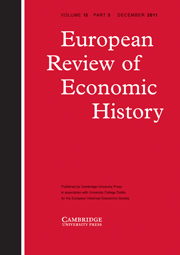Article contents
Infrastructure and economic development in the Netherlands, 1853–1913
Published online by Cambridge University Press: 07 September 2006
Abstract
Economic historians have always assigned a large role to infrastructure in the process of economic growth. For instance, it is commonly agreed that infrastructure endowments made the Netherlands the economic superpower in the pre-industrial era, but depressed economic growth in the first half of the nineteenth century, and then again enabled modern economic growth in the second half of the nineteenth century. However, this hypothesis has never been tested quantitatively, mainly because of the lack of reliable data. A new database on infrastructural investments allows us to confirm the hypothesis for the second half of the nineteenth century. Our main conclusion is that the investments in new infrastructure (mainly railways and waterways), clearly paid off. However, these positive effects lasted only temporarily; the Dutch economy did not switch to a permanently higher growth path. Also, it was some time before entrepreneurs fully reaped the potential benefits of a better infrastructure.
- Type
- Articles
- Information
- Copyright
- Cambridge University Press 1999
- 10
- Cited by


